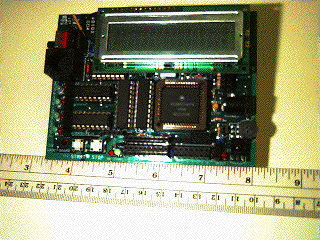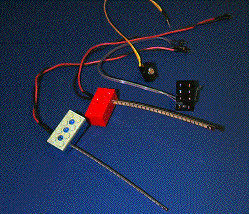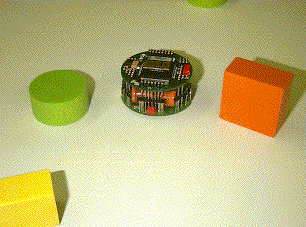Outfitting A Robot Laboratory
![]() Resource Kit
Resource Kit
![]() Sample Syllabus for an AI Course
Sample Syllabus for an AI Course
You will need one station for every 2-3 students. Each station consists of:
Essential Tools
Soldering iron, soldering stand, solder, needle nose pliers, wire cutters, wire stripper, wire wrapping tool, 30 gauge wire, epoxy or hot glue gun (better) for mounting sensors onto LEGO parts, pliers, tweezers, vise, heat shrink tubing for insulating solder joints, hair dryer for activating heat-shrink tubing. Most of these materials can be bought from Radio Shack an electronics supplier, or go scrounging in your physics/electronics labs.
Other Useful Tools
These are not necessary for the beginners but will be nice to have in the long
run: hex keys, jeweler's screw drivers, x-acto knives, multi meters, measuring tape,
power extension cords, etc.

The MIT Handy Board
You can order a Handy Board completely assembled (highly recommended) or in parts (much cheaper but requires serious soldering and assembly experience). The completely assembled version comes ready to run along with cables, a battery charging unit and serial interface. The address and contact information for the vendor is given below:
Gleason Research
P.O. Box 1247
Arlington, MA 02174-0021
Fax/Phone: (781) 641-2551
Email: info@gleasonresearch.com
You also get a free version of IC 2.853. You may order (for a price) a newer version, IC 3.1, from the Newton Research Labs. The Handy Board costs approximately $285.00 and IC 3.X is $35.00 per user license. The commercial version of IC is available from:
Newton research Labs
14813 N.E. 13th Street
Bellvue, WA 98007
Voice: (425) 643-6218
Email: sales@newtonlabs.com
NEWS FLASH (4/2/98):
For all the LEGO parts listed below, check prices at LEGO Shop AT Home Service at 1-800-453-4652. Their prices are MUCH lower (looks like the left arm doesn't know what the right one is up to!). The part numbers may be different but the products are the same.
LEGO parts can be ordered by phone directly from LEGO Dacta/PITSCO Innovative Education (the educational division of LEGO) at 1-800-362-4308. Generally, it is best to ask them for a catalog first (request the catalog on Technology, Science & Math products). We recommend getting the Technology Resource Set (part# 979609, $216.25). This kit contains several (over 1700) different LEGO pieces, but contains only one 9 volt motor. You will need at least two motors per robot and six motors per kit is best. You can order extra LEGO 9 volt motors (part #775114, $24.50). Do not order any of the 4.5 volt parts as the 979609 kit is compatible with 9 volt power, and so is the Handy Board. You can also order LEGO touch sensors (part# 779888, $18.00). At the moment all other listed LEGO sensors are not worth getting as they are incompatible with the Handy Board. The 1998 catalog from LEGO/PITSCO is full of other "extraneous" products that are not particularly useful for the kind of lab we are describing. Most of their products are designed for K-8 schools. For starters, stick with LEGO parts from the catalog, which is why we have provided specific part numbers.
Additionally, you may also want to order the LEGO 9 volt motors that come with gear reduction (part# 775225, $24.50). These motors can directly drive the wheels of the robots without the need for an external great train. LEGO also makes 9 volt micro-motors (part# 775119, $24.50) that can be used for constructing smaller, lighter vehicles. You may also want to order some extra 9 volt connecting leads (part# 779897, $12.25 for a set of three) for wiring the extra motors.
The motors and the sensors have to be (re)wired to plug into the Handy Board ports.
You will need 0.1 inch male header pins to form the plugs. These can be obtained
from electronics suppliers (for example, DIGIKEY 1-800-344-4539, part#929834-07-36-ND,
$1.00 for a strip of 36 pins). Get at least 20 strips.

Some commonly used sensors
Initially touch and light sensors will suffice. The Handy Board pages discuss
several other types of sensors. The touch sensor is basically a switch. The light
sensor is a simple photo resistor. Both are pretty straight forward to wire and can
be purchased from Radio Shack. The switches cost $2.00 a piece and photo resistors
come in packs of 5 for $2.00. You may not want to order any touch sensors from LEGO
at all. Details of wiring these are in the documentation that accompanies the Handy
Board. Gleason Research also sells a Sensor/Motor Kit that contains an assortment
of sensors, motors, and wiring accessories for $35.00.

The Khepera Robot
The K-family of robots are designed and developed by Dr. F. Mondada's group at
LAMI in Lousanne, Switzerland. These
are research-level robots for use in advanced robotics projects. The base robot costs
around $3000.00. You may want to consider getting these if you are interested in
doing research on robot algorithms and/or to provide an advanced facility for your
student research projects.
The Pioneer 1 Robot
These, like the K-family, are advanced robots. They are much larger than Khepera and designed for use in mobile applications. The base robot costs around $3000.00 and once again, should be in consideration for advanced applications. For more information on the Pioneer, see the home page of Real World Interface Inc. the supplier of these robots.
Our robot labs have 10 robot building stations for LEGO/Handy Board based robots.
The lab also has 1 Pioneer and 1 Khepera robot.